Reports
Intensive Nuclear Weapons Component Testing Campaign during the Amad Plan
by David Albright and Sarah Burkhard
March 5, 2020
Under the “Amad Plan,” Iran put in place during the early 2000s a set of five facilities to develop and test key nuclear weapon components and associated diagnostic equipment. Annex 1 of this report contains an original Farsi and a translated table from the Iranian Nuclear Archive, listing 192 tests related to nuclear weapons development performed at those five sites in Iran over a seven-month period, September 23, 2002 to April 20, 2003. Additional testing occurred outside this period of time.
Knowledgeable Israeli analysts, intimately familiar with the documents in the Nuclear Archive, called it an “intensive testing campaign” to prove the capabilities of nuclear weapon Subsystems.1 This document, from a collection of Excel files in the archive, appears to list all of the main nuclear weapons sites testing with propellants and high explosives and outfitted with high-speed diagnostic equipment. Collectively, they are a key aspect of developing nuclear weapons, appearing sufficient to ensure that the subcomponents work alone and in combination.
During this seven-month period, the average number of tests was 32 per month. Figure 1 shows the distribution of the tests over this time period, including an increasing number of tests each month over most of this period, suggesting with regards to nuclear weaponization, the Amad Plan was moving ahead steadily.
The archive contains results of these tests, indicating advancements in the program. However, the results are considered proliferation sensitive and not releasable publicly.
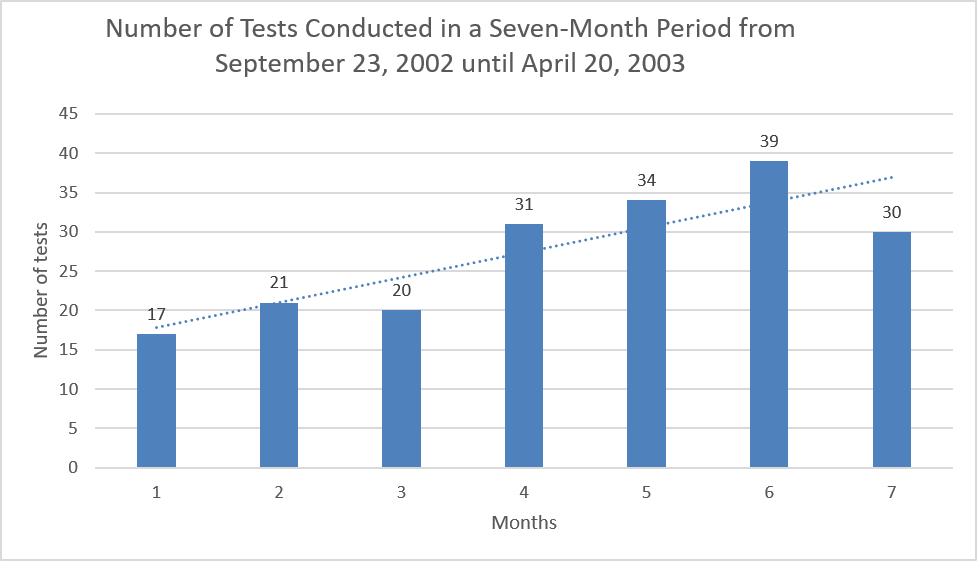
Figure 1. Monthly distribution of tests from September 23, 2002 to April 20, 2003, where month 1 represents the Iranian month “Mehr,” which lasts from September 23 – October 22, 2002, and so forth. The numbers are taken directly from the table in the Annex. A trend line is included to show the mostly steady increase in tests over time.
Figure 2 lists the total number of tests at each testing location of the five sites. Figure 3 shows the relative share of tests at each testing location.
The number of tests given in this document for Sanjarian (the Upper and Lower Nour-Abad chambers) and Golab Dareh are larger than those listed in other archive documents obtained by the Institute. The numbers for Pour Midani match in number and dates in earlier Institute information. The number of tests at Marivan and Parchin (Taleqhan 1 and 2 chambers) represent new public information. Overall, the new document suggests more tests than previously known publicly.
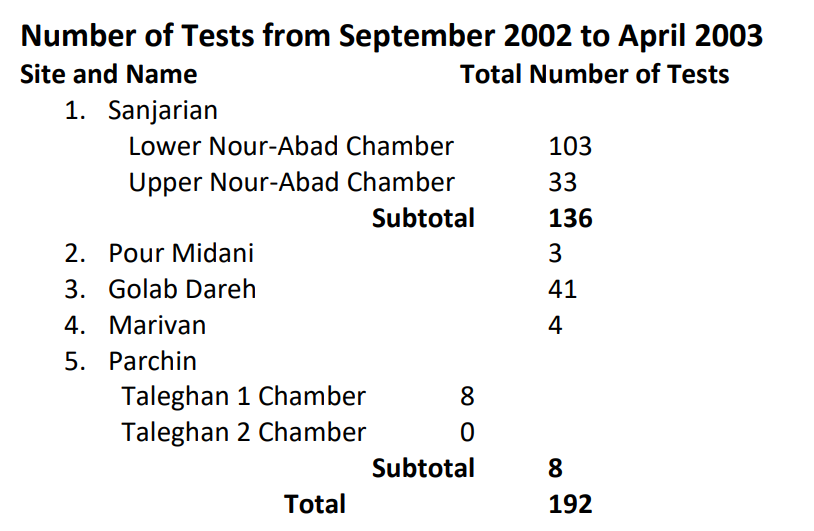
Figure 2. Number of tests at each of five testing sites from September 23, 2002 to April 20, 2003.
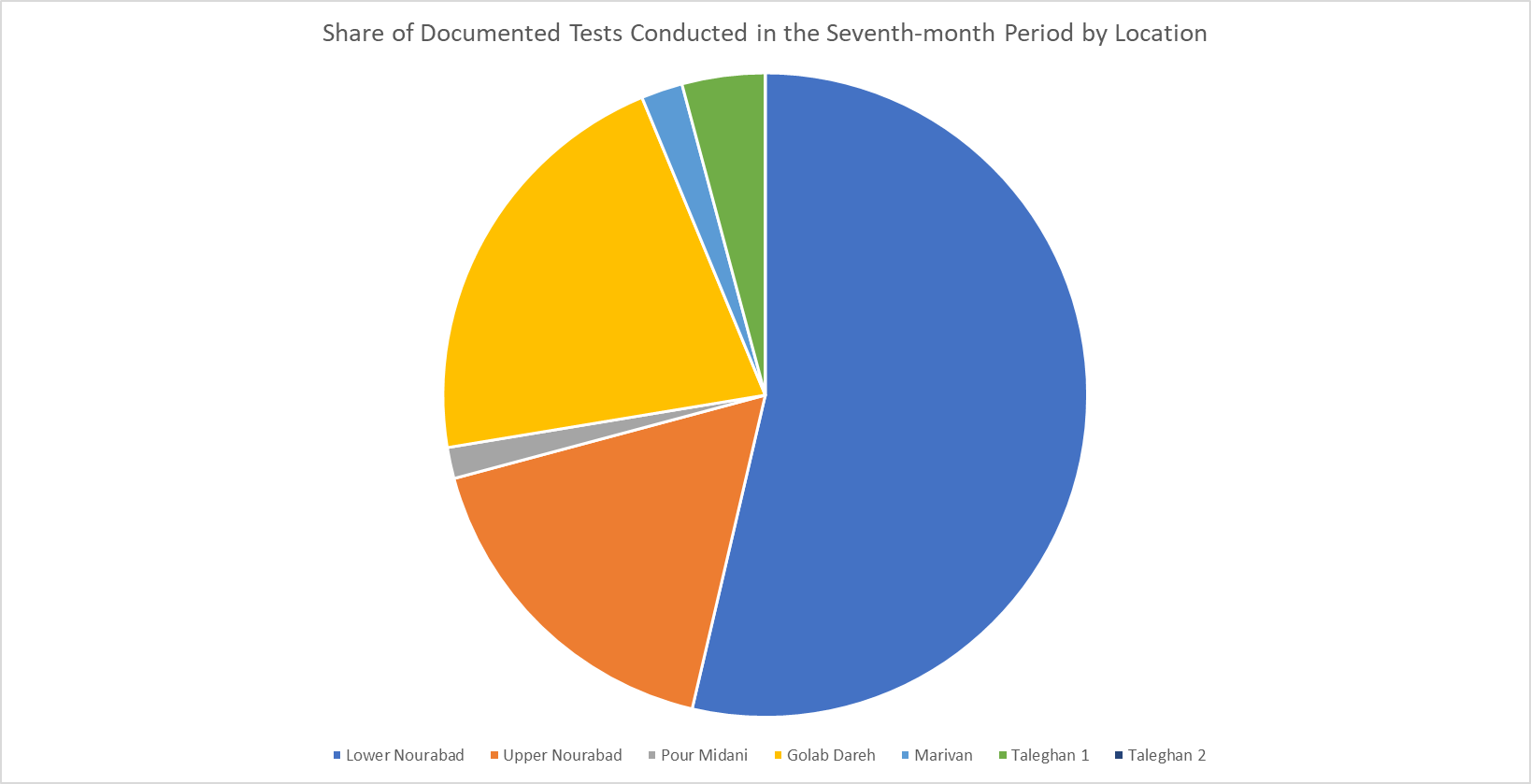
Figure 3. Fraction of tests at each of seven testing locations at the five sites, clockwise.
Interactive Nuclear Weapon Schematic
Figure 4. Nuclear explosive schematic from the Iran Nuclear Archive, translated and annotated by the Institute.
Below is a summary of each site, in the same order as in the table in Annex 1. Other Institute studies contain considerable detail on several of these testing activities and sites. These references are included below. Figure 4 shows an annotated schematic of an Iranian nuclear explosive device, which shows some of the components discussed below.
Sanjarian (Upper Nour-Abad and Lower Nour-Abad Chambers)
This facility, named for a nearby village of that name, made high explosive parts for the shock wave generator and conducted a range of tests for its development. In addition, under the Amad Plan, it was a center for the testing of exploding bridgewires (EBWs), which were necessary for the shock wave generator. Its nuclear weapon-related activities after the Amad Plan remain to be determined. The tests were done in two chambers, called Upper Nour-Abad and Lower Nour-Abad. The majority of the tests listed in the table in Annex 1 were done in these chambers.
A detailed study on activities at Sanjarian can be found at https://isis-online.org/isis-reports/detail/shock-wave-generator-for-irans-nuclear-weapons-program-more-than-a-feasibil/ The new table shows more tests have been conducted at Sanjarian than discussed in the earlier report.
Pour Midani (Part of Project Midan)
The location, near Semnan, is where Project Midan conducted three underground high explosive tests in 2003 as part of developing seismic methods of measuring the yield of an underground nuclear explosive. The tests involved the detonation of three high explosions, ranging from 0.5 to 4.62 tons of TNT in February and April 2003.
A detailed description of activities at Pour Midani can be found at: https://isis-online.org/isis-reports/detail/project-midan-developing-and-building-an-underground-nuclear-test-site-in-i/8
Golab Dareh
The location of this site remains publicly unavailable; it may or may not be located near the village with this name. According to Israeli intelligence officials knowledgeable about the archive, this site was involved in equation of state experiments, including metal flyer plate and velocity experiments. It was also involved in testing photodiodes. A few examples of photodiode tests are mentioned in the Institute study on Sanjarian. A photodiode converts a light signal to a current; these tests may be related to developing fast diagnostic capabilities where light from an explosion is detected in a photodiode and subsequently recorded.
Marivan
The location of this site has not yet been released publicly. The archive shows that the Marivan site undertook work linked to implosion testing for nuclear weapons, including the shock wave generator. It included a set of buildings and an outdoor or tunnel testing location for tests involving larger amounts of high explosives and optical diagnostic equipment. Likely, this site conducted tests involving more high explosives than could be accommodated in the test chambers at the other sites. The meaning of “trap method” in the Farsi language table in the Annex could not be determined, but might be suggestive of testing in tunnels.
The IAEA has provided information about one test at Marivan. According to a 2015 IAEA report:
Prior to November 2011, Member States provided the Agency with information that Iran had available to it design information on the explosives technology known as multipoint initiation (MPI) and that it had used this for the initiation of high explosives in hemispherical geometry. The information indicated that Iran had developed of a hemispherical MPI system and conducted at least one large scale experiment in 2003, details of which were technically consistent, both internally and with publications authored by a certain ‘foreign expert’. The Agency has reassessed that this experiment was conducted at a location called “Marivan”, and not conducted in “the region of” Marivan [as previously reported].2
The IAEA is describing the shock wave generator. At least one full-scale, hemispherical test of the shock wave generator, using sophisticated diagnostic equipment, was conducted at the Marivan site in 2003, according to archive information. This test could have been one of the four tests listed in the testing table conducted at Marivan in the period from February 20 to April 20, 2003.
The site’s activities post 2003 remain to be determined.
Detailed information about such a test at Marivan can be found at: https://isis-online.org/isis-reports/detail/shock-wave-generator-for-irans-nuclear-weapons-program-more-than-a-feasibil
Parchin (Taleghan 1 and Taleghan 2 chambers)
This site housed two specialized high explosive chambers capable for use in nuclear weapons research and development, called Taleghan 1 and Taleghan 2. Taleghan 1, the larger chamber, was used to test a specialized, difficult-to-develop neutron initiator for starting the chain reaction in a fission nuclear explosion. Taleghan 2 was outfitted with a flash x-ray. The new information includes that eight tests were conducted in the Taleghan 1 container during this seven-month period, mostly in early 2003, but none occurred in Taleghan 2 during this same Period. At least one test involving the shock wave generator may have occurred in Taleghan 2 outside this time period.
A detailed description of Taleghan 1 and 2, along with key testing in Taleghan 1, can be found at: https://isis-online.org/isis-reports/detail/new-information-about-the-parchin-site/8
A Few Observations
Annex 2 presents the temporal distribution of the tests by location. This graph shows that testing at the Lower Nour-Abad chamber occurred frequently and doubled during the last part of this period. Testing at Golab Dareh was frequent in this period but appears volatile in numbers, possibly reflecting more diverse types of tests.
The tests in the Upper Nour-Abad chamber were less frequent but relatively steady, likely reflecting their greater sophistication, which is supported by archive documents obtained earlier by the Institute. Testing in this chamber decreased at the same time as the testing at the Marivan site started in month six. This may reflect the stepping up in sophistication of the high explosive experiments, which required larger amounts of high explosives than could be contained in the Upper Nour-Abad test chamber.
The number of tests before or after this seven-month period is currently unknown.
Annex 1
Original Table in Farsi, Translated Table on Next Page
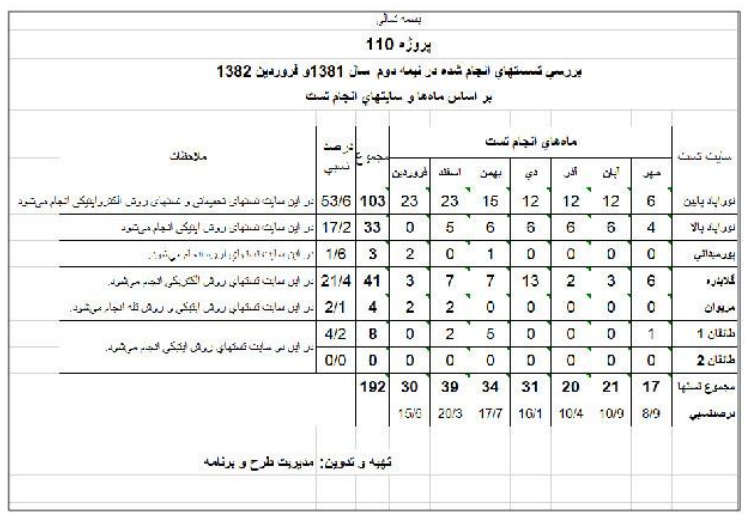
Comments. Project 110 was in charge of the development and production of nuclear weapons. See for example https://isis-online.org/isis-reports/detail/from-irans-nuclear-archive-organizational-chart-of-project-110-amad-supraor/ The triangular symbols in the corner may mean that there are comments.
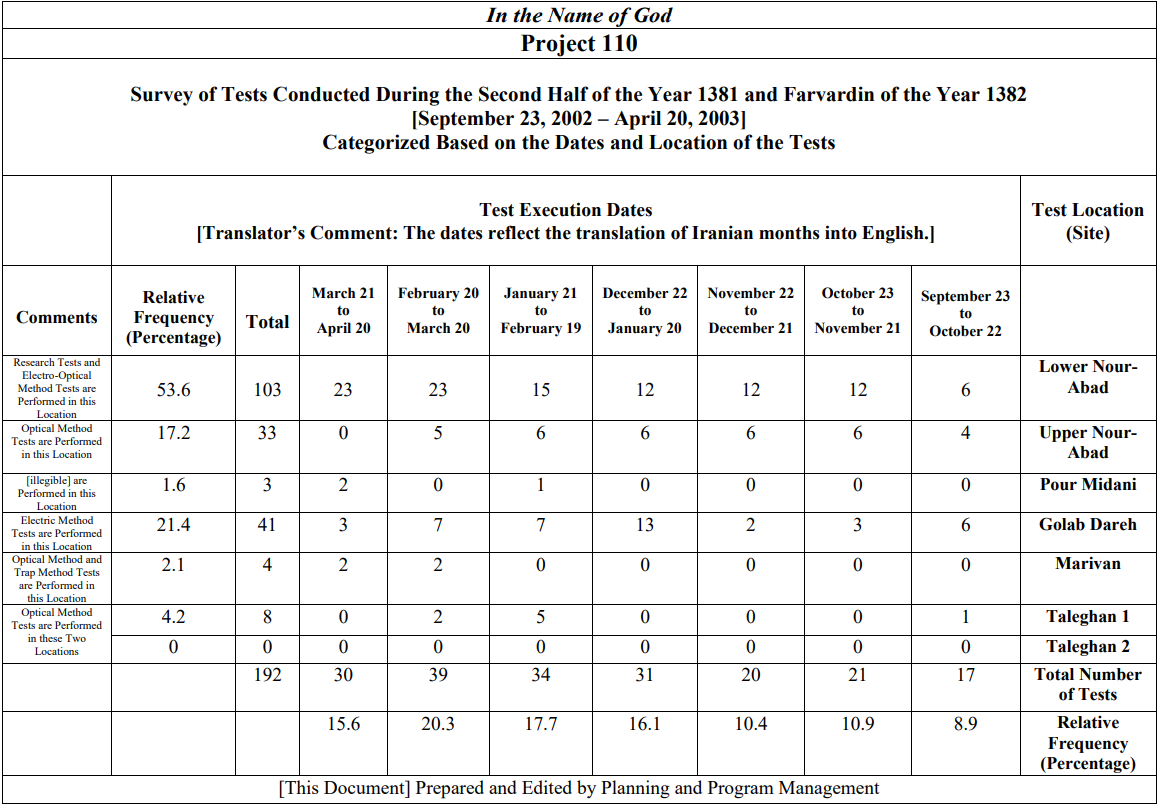
Annex 2 Testing Activity by Location at the Five Sites Listed in the Table in Annex 1.
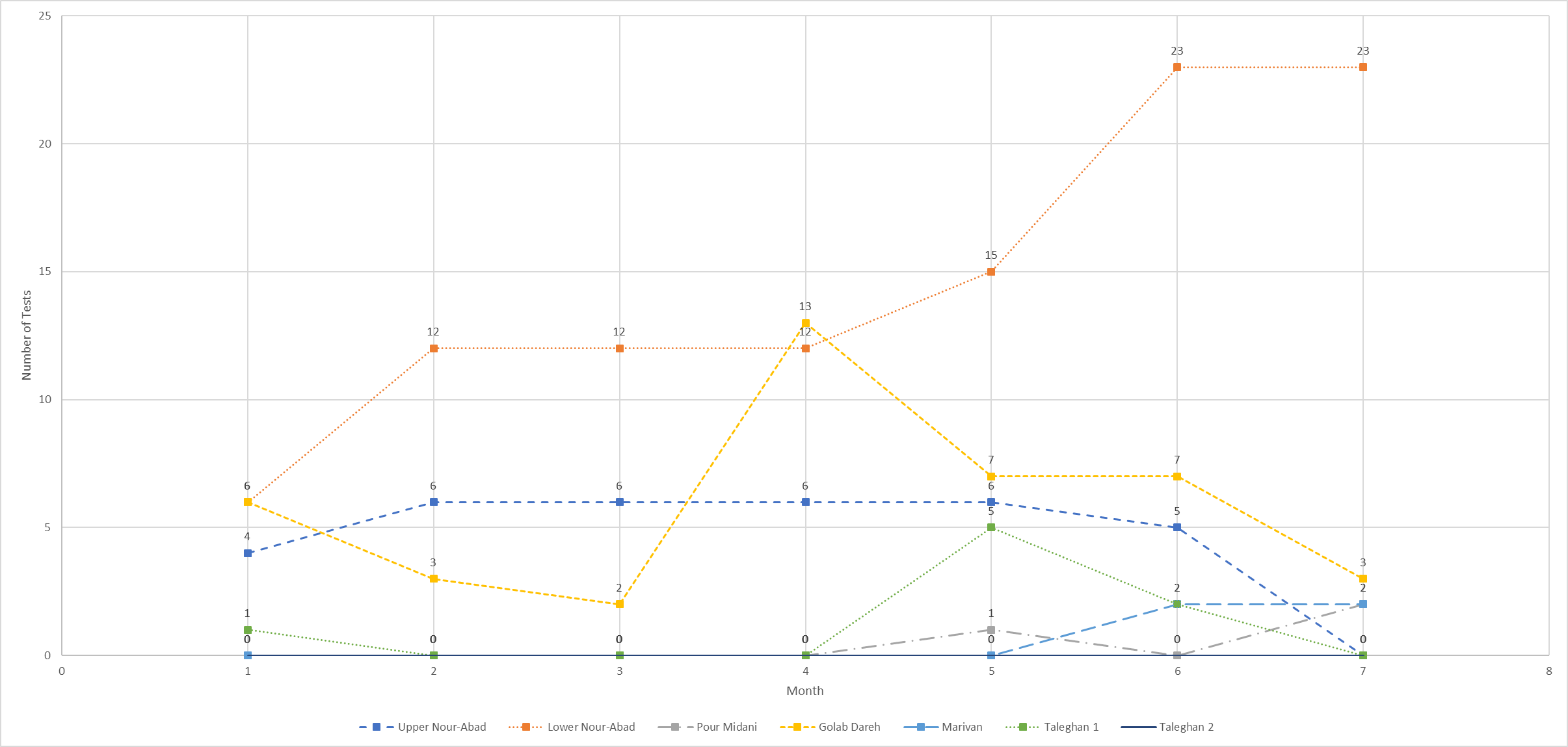
1. Interview with author, Tel Aviv, January 12, 2020. ↩
2.
IAEA Director General, “Final Assessment on Past and Present Outstanding Issues regarding Iran’s Nuclear
Programme,” GOV/2015/68, December 2, 2015,
https://www.iaea.org/sites/default/files/gov-2015-68.pdf ↩

 twitter
twitter